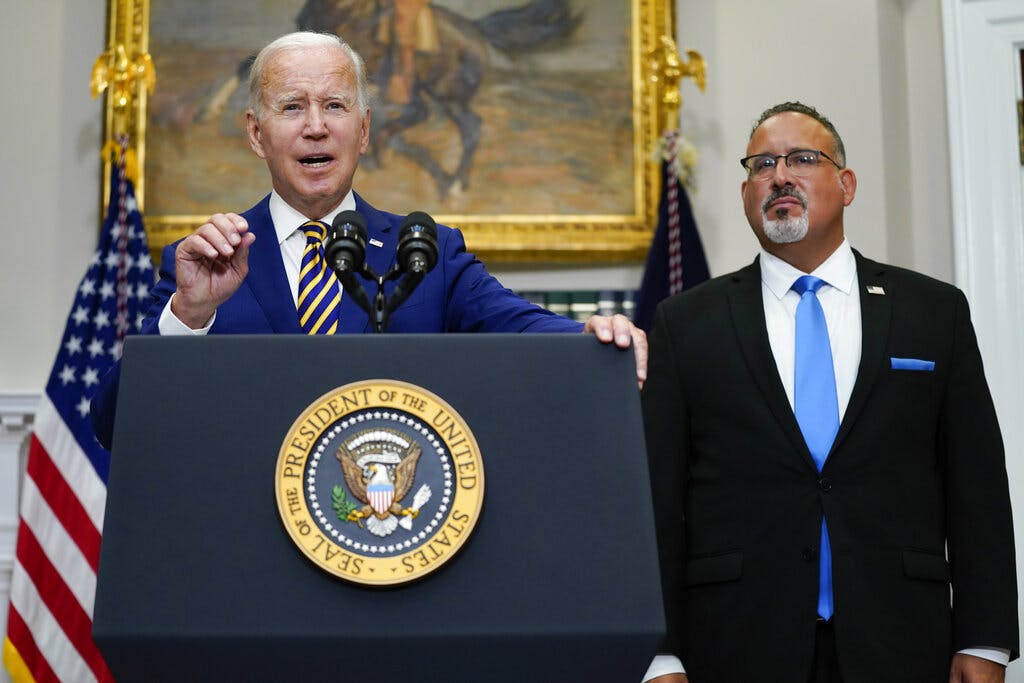Biden Student Loan Changes to Cost Twice as Much as Administration Estimates
The department’s cost estimates unrealistically assume that no additional students will tap the more generous and easily accessible new program.

An independent analysis of President Biden’s proposed changes to the federal student loan program estimates that they will cost more than two times as much as administration officials claimed when they announced the initiatives weeks ago.
Last month, Mr. Biden’s Education Department released details of the changes it wants to make to the Income-Driven Repayment Plan that allows students to pay a portion of their income for a set period of time, at the end of which the debt would be forgiven altogether regardless of the outstanding balance. The department said the cost of the changes to taxpayers would amount to $138 billion during the first decade.
Analysts at the Penn Wharton Budget Model at the University of Pennsylvania said the department’s estimates assume unrealistically that no additional students will tap the more generous and easily accessible new program. The real cost of the program, they suggest, is likely to be between $333 billion and $361 billion, and that doesn’t account for students borrowing more under the new program — an outcome that many analysts have suggested is inevitable.
Mr. Biden’s proposals, part of his wider campaign to erase the student debt of millions of Americans that is currently tied up in the courts, seek to simplify and expand a program that allows borrowers to pay a certain percentage of their post-graduation income for a period of between 10 and 25 years, depending on how much they borrowed. Launched in 2007, the program now has some 8.5 million borrowers enrolled.
Currently, those enrolled in the program must pay 10 percent of their disposable income, but Mr. Biden wants to reduce that amount to 5 percent for undergraduate students. He also wants to raise the threshold that defines what “disposable income” is and determines a student’s monthly payments. Also on tap: shorter repayment periods, an elimination of the accrual of interest on the loans, and automatic enrollment in the new program of borrowers who are late on their payments for other student loan products.
When the education secretary, Miguel Cardona, announced the program, he said the administration is working on setting up a “student loan safety net” for succeeding generations. “We’re changing the culture that higher education isn’t affordable in America, especially for Black and brown and other underserved students,” Mr. Cardona said. “For more Americans to realize the benefits of higher education, we must make paying student loans more affordable.”
The analysts at the Wharton School expect that total loan volumes under these more generous terms are likely to increase by between 33 percent and 75 percent from current levels, which explains the difference between their projections and those of the education department. The analysts also warned that the new rules have the potential to lead to higher tuition rates at many universities as the flow of government subsidies increases.
A senior fellow at the conservative American Enterprise Institute who has tracked the Biden administration’s student loans programs, Beth Akers, also cited evidence that less student loan debt will ultimately be paid off under the new program. Currently, borrowers pay on average $1 back to the Treasury for each dollar they borrow. Going forward, she writes, borrowers are likely to pay half of that, or about 50 cents for every dollar they borrow. Taxpayers, she said, would be on the hook for those shortfalls.
“If the White House moves ahead with this plan, they’ll be undermining the entire system of federal student borrowing — replacing it with a convoluted, opaque system of subsidies that benefit many middle and high earners; incentivizing people to borrow more than ever before; and putting the burden of paying for all of it onto taxpayers,” Ms. Akers said.
Another critic of the proposal, Congresswoman Virginia Foxx, a Republican of North Carolina who heads the House Education and Workforce Committee, said that the new repayment plan would “turn the federal loan program into an untargeted grant with complete disregard for the taxpayers that fund it.”
The proposals are “a repeat of the same playbook that got us into this college affordability crisis in the first place,” Ms. Foxx said. “Because President Biden couldn’t get his radical free college agenda through Congress, he has resorted to doing it through the backdoor by executive fiat.”
The department is soliciting public input on its plan through February 10. As of Tuesday, 6,873 people have weighed in on the proposed changes.

